Colonial Ancestors
EARLY SETTLERS: Western Virginia 1700-1800
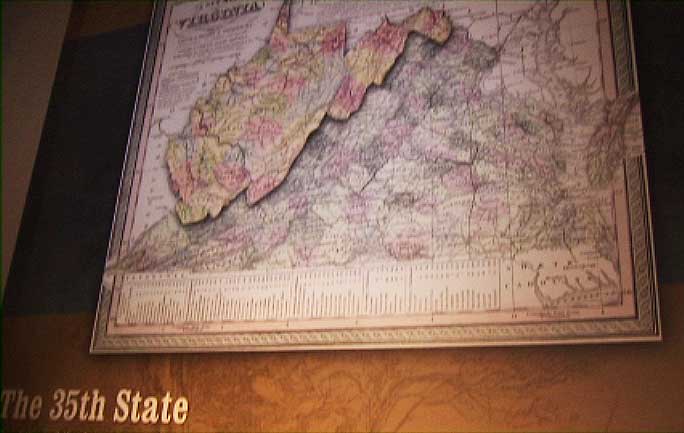 West Virginia became a state in 1863
West Virginia became a state in 1863
The FOUNDERS of the Colonial Dames of America in the State of West Virginia (established in 1900) were dedicated to preserving a popular interest in history and honoring their colonial ancestors.
In Western Virginia in the 1700s, settlers bravely crossed the rugged hills and mountains to find a new life. Many colonists arrived through the Valley of Virginia, a narrow corridor between the Blue Ridge and Allegheny mountains.
In 1716, Lt. Governor Alexander Spotswood and his Knights of the Golden Horseshoe claimed the Shenandoah region in Virginia for England. Spotswood honored any settler who dared to cross the mountains as Knights of the Golden Horseshoe and awarded them a golden horseshoe. Spotswood was accompanied by fifty gentlemen, their servants, and Indian guides in the first journey. This heroic quest is carried on today by the West Virginia Department of Education who honor exceptional and daring West Virginia history students as academic Knights of the Golden Horseshoe.
In the 1700s all of Western Virginia was the wild frontier and settlers were attracted to the dangers in the wild and wonderful land. In Anna Smucker’s book A History of West Virginia, she calls West Virginia “…a place where hills and hollows are part of its people, a place where family has always been important.” She tells the story of a people – West Virginians – proud to call this beautiful, rugged land home.
PIONEER HISTORY AT THE WEST VIRGINIA MUSEUM
The frontier exhibit tells the story of Western Virginia’s brave men and women who were rugged adventurers and independent, self-reliant, seekers of freedom. Most settlers were poor and of European ancestry; they built their own homes out of logs and made everything by hand. Their food supply consisted of game and native fruits – they could not grow gardens because of Indian attacks. Forts were established at the falls of rivers and villages grew around forts. The frontier families would have crossed the Blue Ridge or the Allegheny mountains on horseback and on foot.
THE WEST VIRGINIA ON-LINE ENCYCLOPEDIA – SOURCE FOR YOUTH
The West Virginia (online)Encyclopedia (e-wv) is an exciting depository of West Virginia history that makes learning fun from the home computer as students learn about this important chapter in West Virginia history.
-
- Search these heroes and heroines by visiting e-wv.
- Discover the journey of pioneers who traveled the Midland Trail, the oldest road in America. Great herds of buffalo beat this east-west path across the Appalachians. Shawnee dragged captive Mary Draper Ingles across parts of it. Daniel Boone hiked it. George Washington and Andrew Lewis first surveyed and owned it. Stagecoaches rumbled over it and soldiers burnt its bridges. Booker T. Washington walked it. Collis P. Huntington’s railroad passed through the New River Gorge, leaving it in the dust until the automobile revived a need for it. Generations of ghosts haunt every mile of the Midland Trail. It is the scene of over 200 years of exploration, conquest, and American industrial history. Learn more at www.MidlandTrail.com.
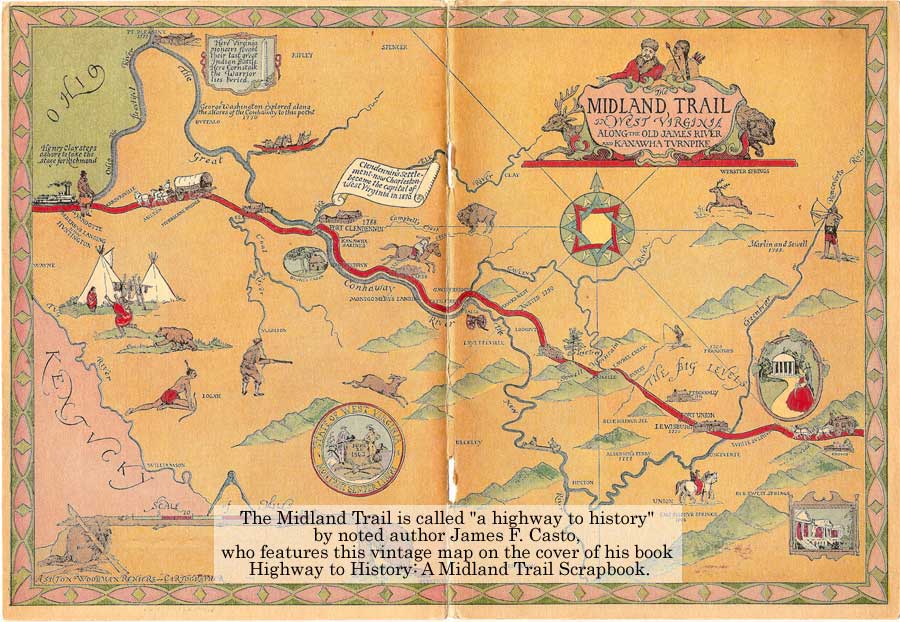
-
- Discover how George Washington blazed the trail by clearing it in 1790.
- Enjoy the modern Midland Trail – the oldest road in America – one of the best West Virginia scenic byways and historical routes. Route 60 winds 180-miles across West Virginia’s midsection offering enthralling vistas and waterfalls, rivers and streams, majestic mountains and waterfalls, cool breezes, white water rafting, and pioneer history.
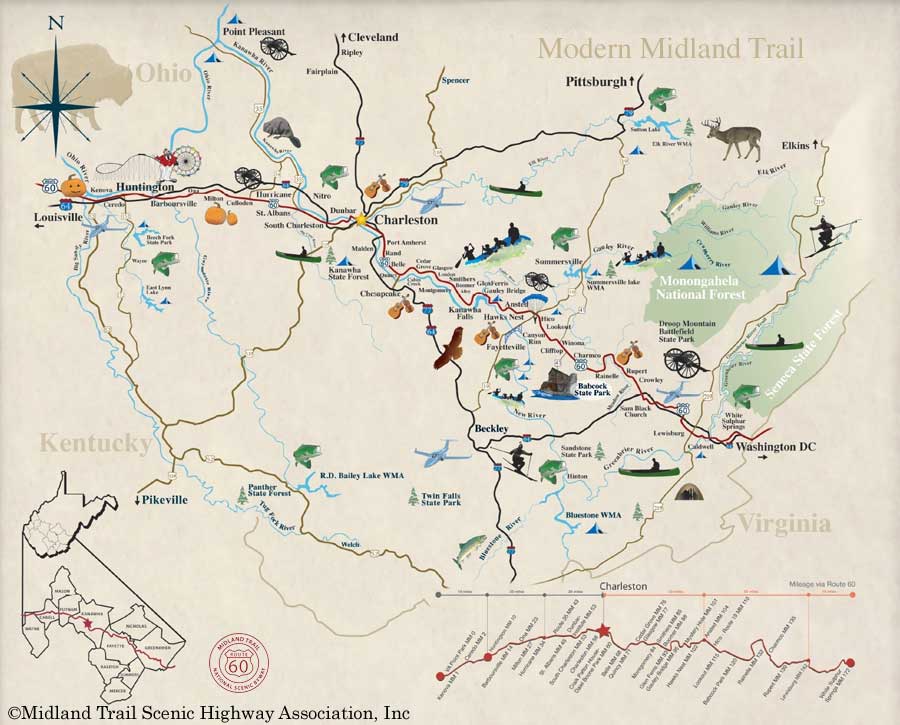
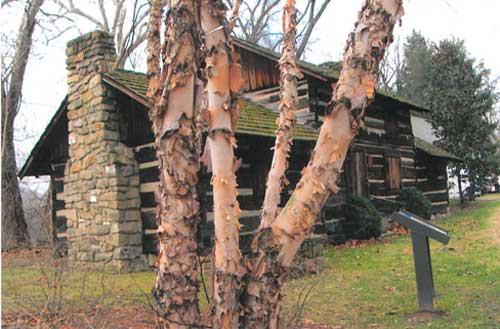 The Ruffner Log Cabin in Daniel Boone Park along the Midland Trail in Charleston, West Virginia
The Ruffner Log Cabin in Daniel Boone Park along the Midland Trail in Charleston, West VirginiaAlong Route 60 in Charleston, West Virginia, you will find an example of a log cabin representing frontier America and the Craik-Patton House, representing the Founders of the Nation Period – both located in Daniel Boone Park.
PIONEERS IN WEST VIRGINIA HISTORY
George Clendenin (1746-1797) – Founder of Charleston and leader who built Fort Clendenin (Fort Lee) to protect settlers from the Indians. He named the village “Charles Town” in honor of his father, Charles Clendenin, a native of Scotland, who first lived in the Shenandoah Valley of Virginia. The village of Charles Town (later Charleston) grew around the fort. The stockade built by George Clendenin and the settlers servd as the first courthouse in Kanawha County.
General Andrew Lewis – One Founder of Lewisburg, first camped and surveyed the area in 1751 with his father, John, and brother, Thomas. In 1774 General Lewis assembled more than 1,000 frontier militiamen in Lewisburg and marched 161 miles along the Midland Trail to Point Pleasant to fight Chief Cornstalk.
Daniel Boone (1734-1820) – Boone was in Western Virginia for 12 years where he became a frontier legend. Daniel Boone Park in Charleston bears his name, and Boone County in Western Virginia bears his name because he rescued a young girl from the Indians. Boone was also a hero in five other states. He served with George Clendenin in the Virginia legislature and militia.
Anne Bailey – The eccentric frontier woman who helped the settlers as a scout and Indian fighter; she was welcomed by all homesteads. She supposedly made two rides by horseback in 1788 through the wilderness to Lewisburg to secure gun powder for the militia at Fort Clendenin (Fort Lee).
Mary Draper Ingles (1732-1815) was the Virginia settler who was captured by the Indians at age 23 when Shawnee Indians took her captive to what is now Pt. Pleasant, West Virginia. Her heroic escape as she followed the New River in Western Virginia illustrates the bravery of frontier women and the dangers of living in the new land. Her exciting story is narrated in the book Follow the River by James Alexander.
Joseph Ruffner (1739-1803) – Pioneer Joseph Ruffner came from the Shenandoah Valley to the Kanawha Valley and built a log cabin around 1797 with the help of his sons and slaves. The Ruffner Log cabin is one of the oldest known buildings erected in what is now Charleston. The log cabin is now located in Daniel Boone Park in Charleston. Ruffner bought the Clendenin land after the death of the Clendenin patriarch, Charles Clendenin. The Ruffners were successful in developing the salt industry in Charleston and were community builders.
Elizabeth “Betty” Zane (1760-1823) – Betty is credited with saving Fort Henry in Wheeling, Western Virginia, when it was attacked in 1782 by Native Americans and the British during the Revolutionary War. It is generally accepted that she ran from the fort to retrieve gunpowder probably carried in her apron.
DANIEL BOONE: FRONTIER LEGEND IN SIX STATES
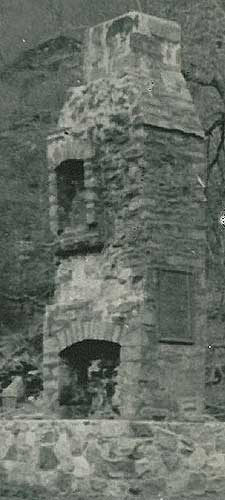 The NSCDA-WV chimney marker honoring Daniel Boone as a “Pioneer of Civilization” at Falls View, West Virginia, on the Midland Trail
The NSCDA-WV chimney marker honoring Daniel Boone as a “Pioneer of Civilization” at Falls View, West Virginia, on the Midland TrailThe Colonial Dames of West Virginia erected a monument paying tribute to Daniel Boone calling him a “pilot of civilization”; on April 11, 1929, the Colonial Dames of West Virginia placed a commemorative marker on the chimney of the Huddleston homesite in Falls View on the Kanawha River along the MIdland Trail at Boone’s favorite West Virginia campsite.
Daniel Boone was a Western Virginia pioneer, surveyor, Indian fighter, hunter, trapper and statesman who first arrived in the Point Pleasant, Western Virginia area in approximately 1786. From Point Pleasant, Boone and his family moved up the Kanawha River in 1789 and settled on the south side of the Kanawha River (current South Charleston) where they lived for approximately 10 years until 1799.
The Boone house was of rough-hewn logs and was built in two parts of one room each. There was a passage between the rooms and a long porch in front.
From a cave in a cliff above the river, Boone hunted deer that he could spot as he looked down from the cave. He also made salt from a spring at the water’s edge which he used to preserve game. Boone taught many of the settlers how to use the beaver trap, protected settlers from the Indians, and shared his hunting skills with all the settlers. The beaver pelts were fashioned into jackets and rugs for warmth to help survive the cold winters.
In 1787 Boone was on a hunting and trapping expedition at his favorite campsite, Twin Falls, as related by reporter Joe Savage writing for the Charleston Gazette. On this trip, Boone and John Paddy Huddleston “exterminated a whole colony of beaver” near the falls. Boone and Huddleston hunted for survival, as meat was the main staple of the pioneer food supply. A settler’s life was hard because of Indian attacks. The settlers had no crops, no grain to make bread, no mill to grind grain, and no stores or markets. They lived on game, nuts and berries. They had to keep constant watch because of Indians and wild animals.
In 1789-1791, during the Indian Wars, Boone was a lieutenant colonel of the Kanawha Militia who served with his friend Col. George Clendenin. Both men also served together as delegates to the Virginia Assembly and were instrumental in the creation of Kanawha County. According to the Savage article: “When Boone first served in the legislature, he shouldered his pack, took his gun, and made the entire trip to Richmond and return on foot.”
A roadside marker erected in Daniel Boone Park, Charleston, West Virginia, on Route 60, Charleston, was established by The West Virginia Department of Culture and History (1979) on the north side of the Kanawha River. Boone and his family lived in a log cabin on the Kanawha for approximately 10 years.
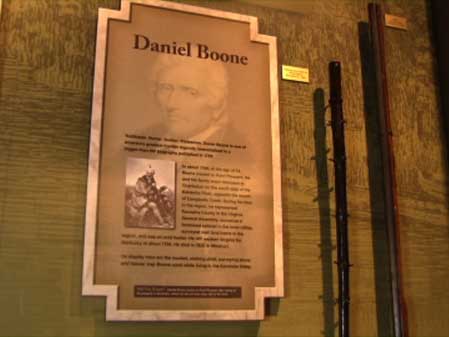 See the Daniel Boone Exhibit at the West Virginia State Museum at the Capitol Complex in Charleston, West Virginia.
See the Daniel Boone Exhibit at the West Virginia State Museum at the Capitol Complex in Charleston, West Virginia.The Daniel Boone exhibit at the State Museum of History in Charleston titled “Daniel Boone Exhibit: One of America’s Greatest Frontier Legends” displays the rifle Boone used in West Virginia, his walking stick, a beaver trap, and a surveying stone with his name painted on it. Before Boone died in 1820, he blazed trails in the states of Pennsylvania, North Carolina, West Virginia, Kentucky, Tennessee and Missouri.
John P. Hale (1824-1902) was one of the early historians in the Kanawha Valley. In 1883 he published a pamphlet on Daniel Boone’s years in the Kanawha Valley. In 1886 he published his classic book Trans-Allegheny Pioneers. He helped found the West Virginia Historical and Antiquarian Society in 1890, the predecessor of the State Archives.
THE RUFFNER LOG HOUSE
Daniel Boone’s log cabin did not survive, but the reconstructed Ruffner Log Cabin originally built in 1797 is now located in Charleston’s Daniel Boone Park. The original Ruffner Log Cabin stood at 1538 Kanawha Bouvelard and was built by Joseph Ruffner, his sons and slaves.
In 1794, Joseph Ruffner purchased 502 acres in the Kanawha Valley; within five years he owned all of the Clendenin land. In 1795, Joseph Ruffner brought his entire family to the Kanawha Valley. Joseph Ruffner’s land included log structures of Fort Clendenin and all of the bottomland surrounding the fort.
The Ruffner log cabin is was one of the largest log cabins in the United States and the hand-hewn logs used in the cabin are among the largest ever encountered. Although the Ruffner Log House does not contain all the original logs and has been improperly reconstructed, it is a popular spot when students visit the Craik-Patton House for School Days tours.
A bronze plaque commemorates the restoration of the Ruffner Log House as a Bicentennial Project presented to the people of Charleston on October 31, 1976.
Sources:
Topper Sherwood, “Historic Craik-Patton House” and “The Ruffner Log House,” Wonderful West Virginia, December 1991. 3-8.
“Preservationist looks at homes,” The Charleston Gazette (April 29, 1970).
EDITOR’S NOTE TO YOUTH: The Colonial Dames of West Virginia designed this section of the website to create interest in FRONTIER HEROES AND HEROINES throughout Western Virginia during the Colonial Period.
If you have a story of a hero or heroines who lived during the 1700s in Western Virginia and would like to have your story and photograph included on the NSCDA WV website, please email the editor at DameRebeccaFrances@gmail.com(.)
WE WANT TO HEAR FROM YOU! SHARE YOUR STORY ABOUT THE FRONTIER HERO/HEROINE IN YOUR AREA OF WEST VIRGINIA!
